Centre for Entrepreneurship Report 2022
VerifiedAdded on 2022/10/12
|11
|1542
|17
AI Summary
Contribute Materials
Your contribution can guide someone’s learning journey. Share your
documents today.
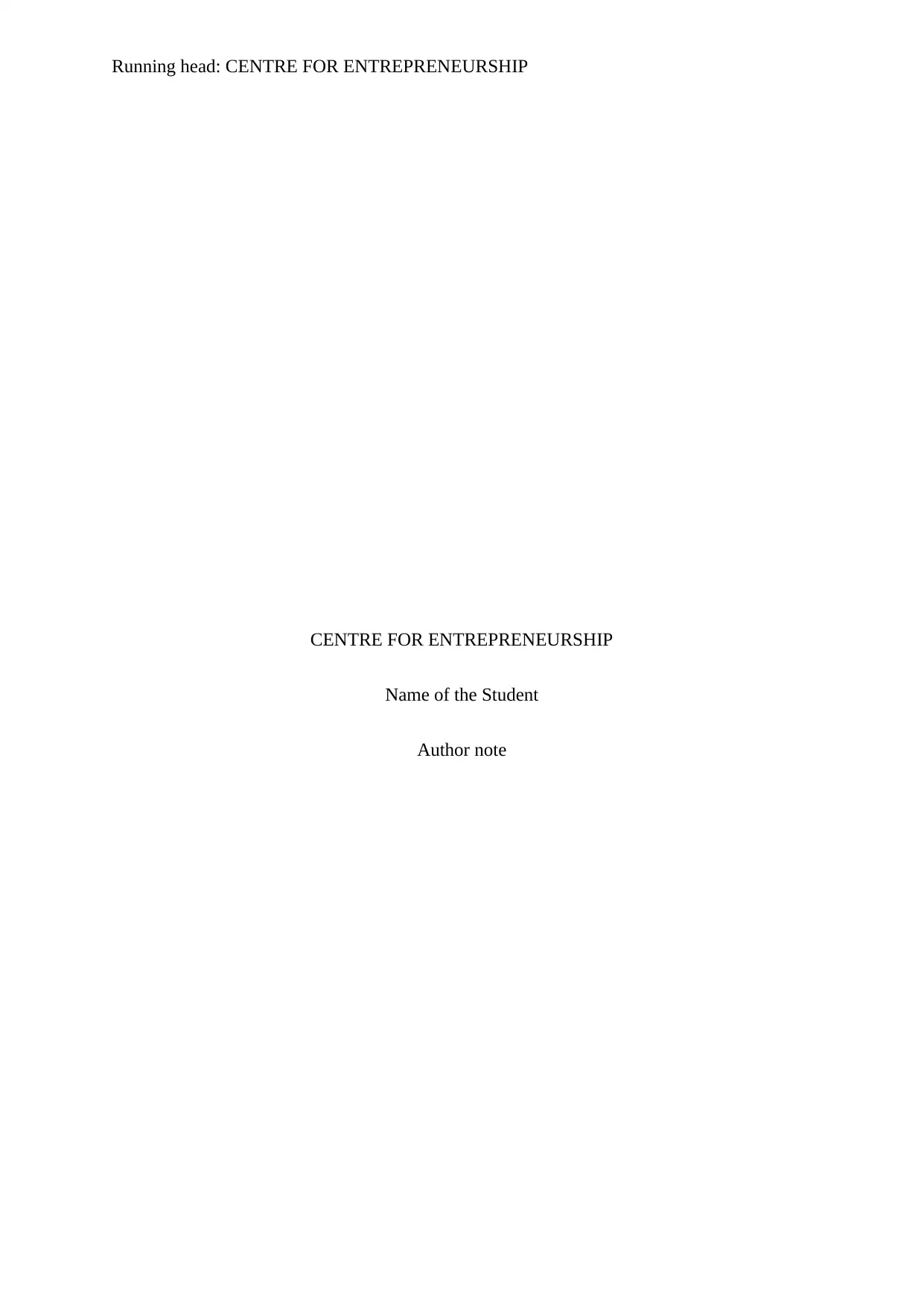
Running head: CENTRE FOR ENTREPRENEURSHIP
CENTRE FOR ENTREPRENEURSHIP
Name of the Student
Author note
CENTRE FOR ENTREPRENEURSHIP
Name of the Student
Author note
Secure Best Marks with AI Grader
Need help grading? Try our AI Grader for instant feedback on your assignments.

1CENTRE FOR ENTREPRENEURSHIP
Executive summary
The purpose of this report is 2 find out the level of awareness that students have in the
Conestoga college about the centre for entrepreneurship. The survey results suggest that the
students are not at all aware of the services of the centre. Recommendations include
promoting with credibility and feasibility in mind, promoting through credible sources and
personalities while focusing on the importance of education in entrepreneurship, and even co-
ownership between students and institution.
Executive summary
The purpose of this report is 2 find out the level of awareness that students have in the
Conestoga college about the centre for entrepreneurship. The survey results suggest that the
students are not at all aware of the services of the centre. Recommendations include
promoting with credibility and feasibility in mind, promoting through credible sources and
personalities while focusing on the importance of education in entrepreneurship, and even co-
ownership between students and institution.

2CENTRE FOR ENTREPRENEURSHIP
Table of Contents
Introduction................................................................................................................................3
Objective....................................................................................................................................3
Discussions.................................................................................................................................3
Survey results.........................................................................................................................3
Analysis..................................................................................................................................7
Literature review....................................................................................................................8
Conclusion and recommendations.............................................................................................9
References................................................................................................................................10
Table of Contents
Introduction................................................................................................................................3
Objective....................................................................................................................................3
Discussions.................................................................................................................................3
Survey results.........................................................................................................................3
Analysis..................................................................................................................................7
Literature review....................................................................................................................8
Conclusion and recommendations.............................................................................................9
References................................................................................................................................10
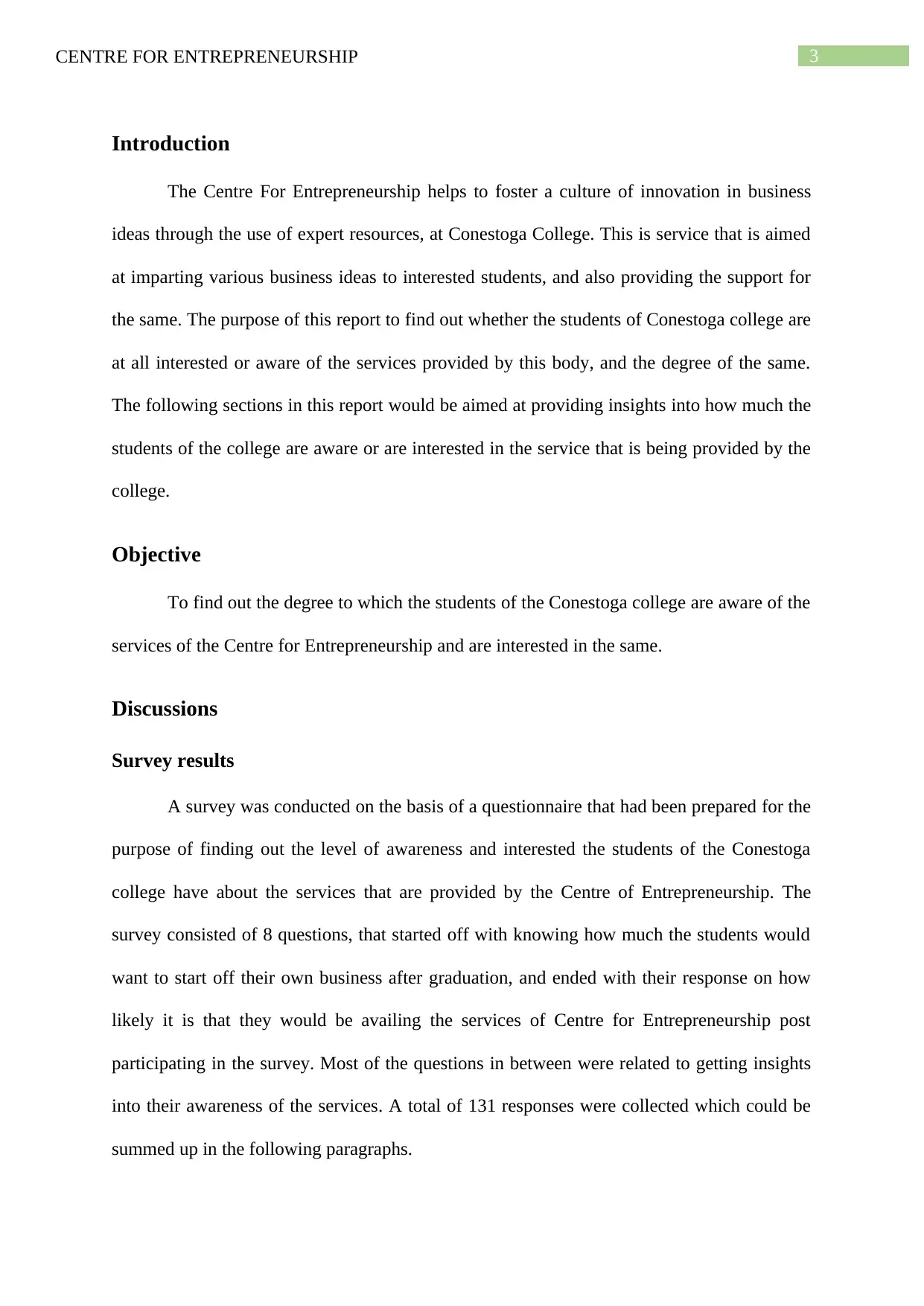
3CENTRE FOR ENTREPRENEURSHIP
Introduction
The Centre For Entrepreneurship helps to foster a culture of innovation in business
ideas through the use of expert resources, at Conestoga College. This is service that is aimed
at imparting various business ideas to interested students, and also providing the support for
the same. The purpose of this report to find out whether the students of Conestoga college are
at all interested or aware of the services provided by this body, and the degree of the same.
The following sections in this report would be aimed at providing insights into how much the
students of the college are aware or are interested in the service that is being provided by the
college.
Objective
To find out the degree to which the students of the Conestoga college are aware of the
services of the Centre for Entrepreneurship and are interested in the same.
Discussions
Survey results
A survey was conducted on the basis of a questionnaire that had been prepared for the
purpose of finding out the level of awareness and interested the students of the Conestoga
college have about the services that are provided by the Centre of Entrepreneurship. The
survey consisted of 8 questions, that started off with knowing how much the students would
want to start off their own business after graduation, and ended with their response on how
likely it is that they would be availing the services of Centre for Entrepreneurship post
participating in the survey. Most of the questions in between were related to getting insights
into their awareness of the services. A total of 131 responses were collected which could be
summed up in the following paragraphs.
Introduction
The Centre For Entrepreneurship helps to foster a culture of innovation in business
ideas through the use of expert resources, at Conestoga College. This is service that is aimed
at imparting various business ideas to interested students, and also providing the support for
the same. The purpose of this report to find out whether the students of Conestoga college are
at all interested or aware of the services provided by this body, and the degree of the same.
The following sections in this report would be aimed at providing insights into how much the
students of the college are aware or are interested in the service that is being provided by the
college.
Objective
To find out the degree to which the students of the Conestoga college are aware of the
services of the Centre for Entrepreneurship and are interested in the same.
Discussions
Survey results
A survey was conducted on the basis of a questionnaire that had been prepared for the
purpose of finding out the level of awareness and interested the students of the Conestoga
college have about the services that are provided by the Centre of Entrepreneurship. The
survey consisted of 8 questions, that started off with knowing how much the students would
want to start off their own business after graduation, and ended with their response on how
likely it is that they would be availing the services of Centre for Entrepreneurship post
participating in the survey. Most of the questions in between were related to getting insights
into their awareness of the services. A total of 131 responses were collected which could be
summed up in the following paragraphs.
Secure Best Marks with AI Grader
Need help grading? Try our AI Grader for instant feedback on your assignments.
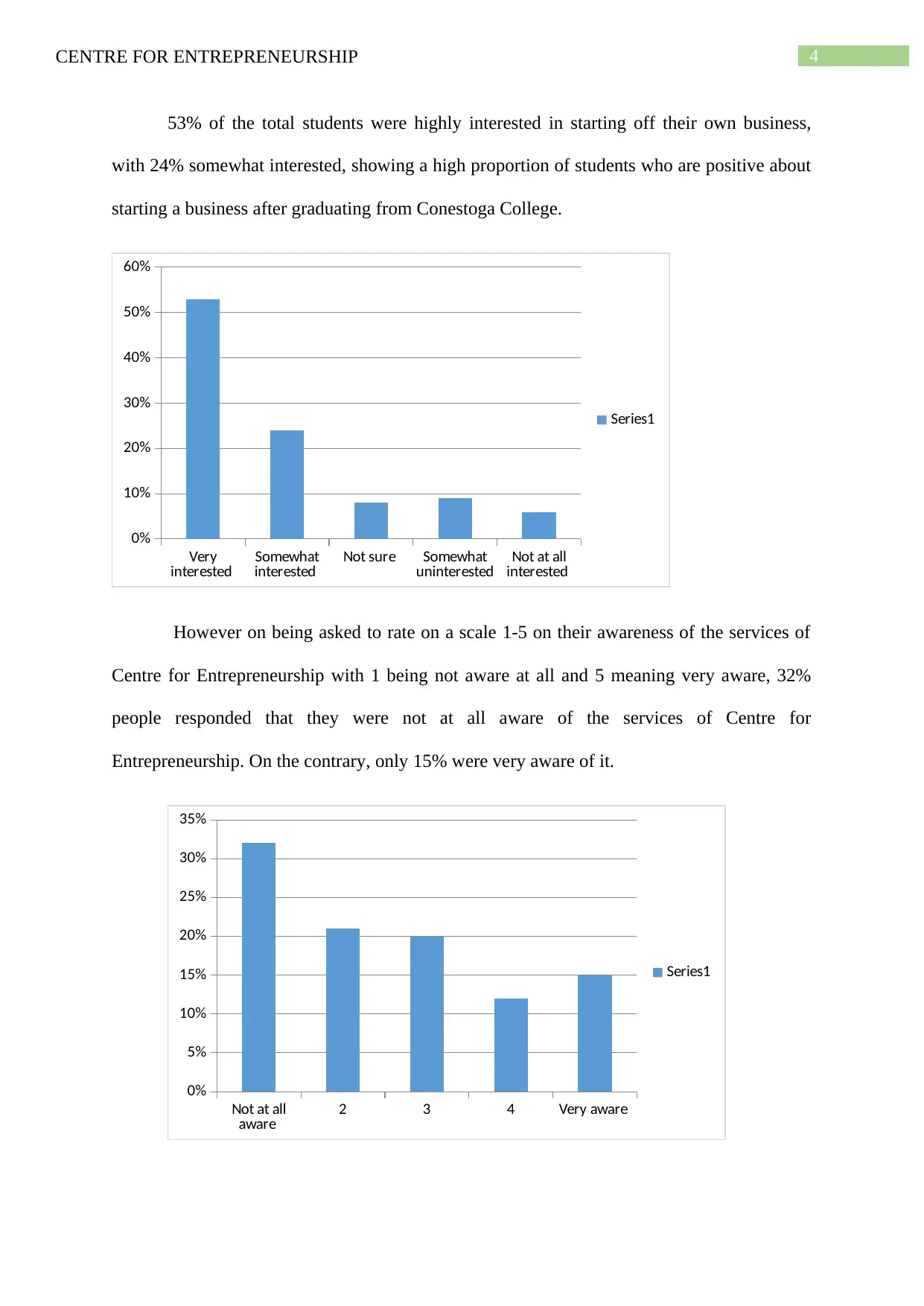
4CENTRE FOR ENTREPRENEURSHIP
53% of the total students were highly interested in starting off their own business,
with 24% somewhat interested, showing a high proportion of students who are positive about
starting a business after graduating from Conestoga College.
Very
interested Somewhat
interested Not sure Somewhat
uninterested Not at all
interested
0%
10%
20%
30%
40%
50%
60%
Series1
However on being asked to rate on a scale 1-5 on their awareness of the services of
Centre for Entrepreneurship with 1 being not aware at all and 5 meaning very aware, 32%
people responded that they were not at all aware of the services of Centre for
Entrepreneurship. On the contrary, only 15% were very aware of it.
Not at all
aware 2 3 4 Very aware
0%
5%
10%
15%
20%
25%
30%
35%
Series1
53% of the total students were highly interested in starting off their own business,
with 24% somewhat interested, showing a high proportion of students who are positive about
starting a business after graduating from Conestoga College.
Very
interested Somewhat
interested Not sure Somewhat
uninterested Not at all
interested
0%
10%
20%
30%
40%
50%
60%
Series1
However on being asked to rate on a scale 1-5 on their awareness of the services of
Centre for Entrepreneurship with 1 being not aware at all and 5 meaning very aware, 32%
people responded that they were not at all aware of the services of Centre for
Entrepreneurship. On the contrary, only 15% were very aware of it.
Not at all
aware 2 3 4 Very aware
0%
5%
10%
15%
20%
25%
30%
35%
Series1
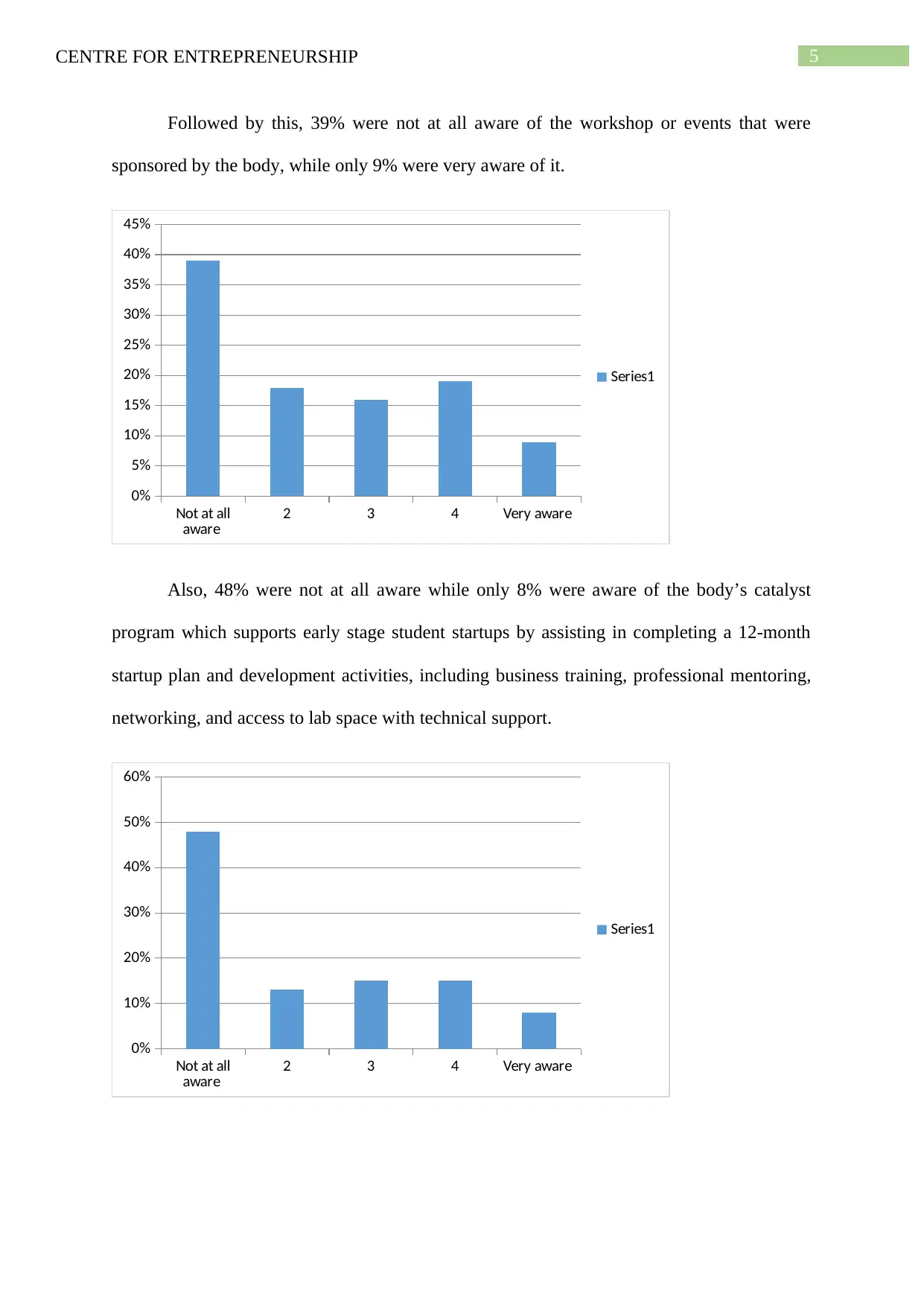
5CENTRE FOR ENTREPRENEURSHIP
Followed by this, 39% were not at all aware of the workshop or events that were
sponsored by the body, while only 9% were very aware of it.
Not at all
aware 2 3 4 Very aware
0%
5%
10%
15%
20%
25%
30%
35%
40%
45%
Series1
Also, 48% were not at all aware while only 8% were aware of the body’s catalyst
program which supports early stage student startups by assisting in completing a 12-month
startup plan and development activities, including business training, professional mentoring,
networking, and access to lab space with technical support.
Not at all
aware 2 3 4 Very aware
0%
10%
20%
30%
40%
50%
60%
Series1
Followed by this, 39% were not at all aware of the workshop or events that were
sponsored by the body, while only 9% were very aware of it.
Not at all
aware 2 3 4 Very aware
0%
5%
10%
15%
20%
25%
30%
35%
40%
45%
Series1
Also, 48% were not at all aware while only 8% were aware of the body’s catalyst
program which supports early stage student startups by assisting in completing a 12-month
startup plan and development activities, including business training, professional mentoring,
networking, and access to lab space with technical support.
Not at all
aware 2 3 4 Very aware
0%
10%
20%
30%
40%
50%
60%
Series1
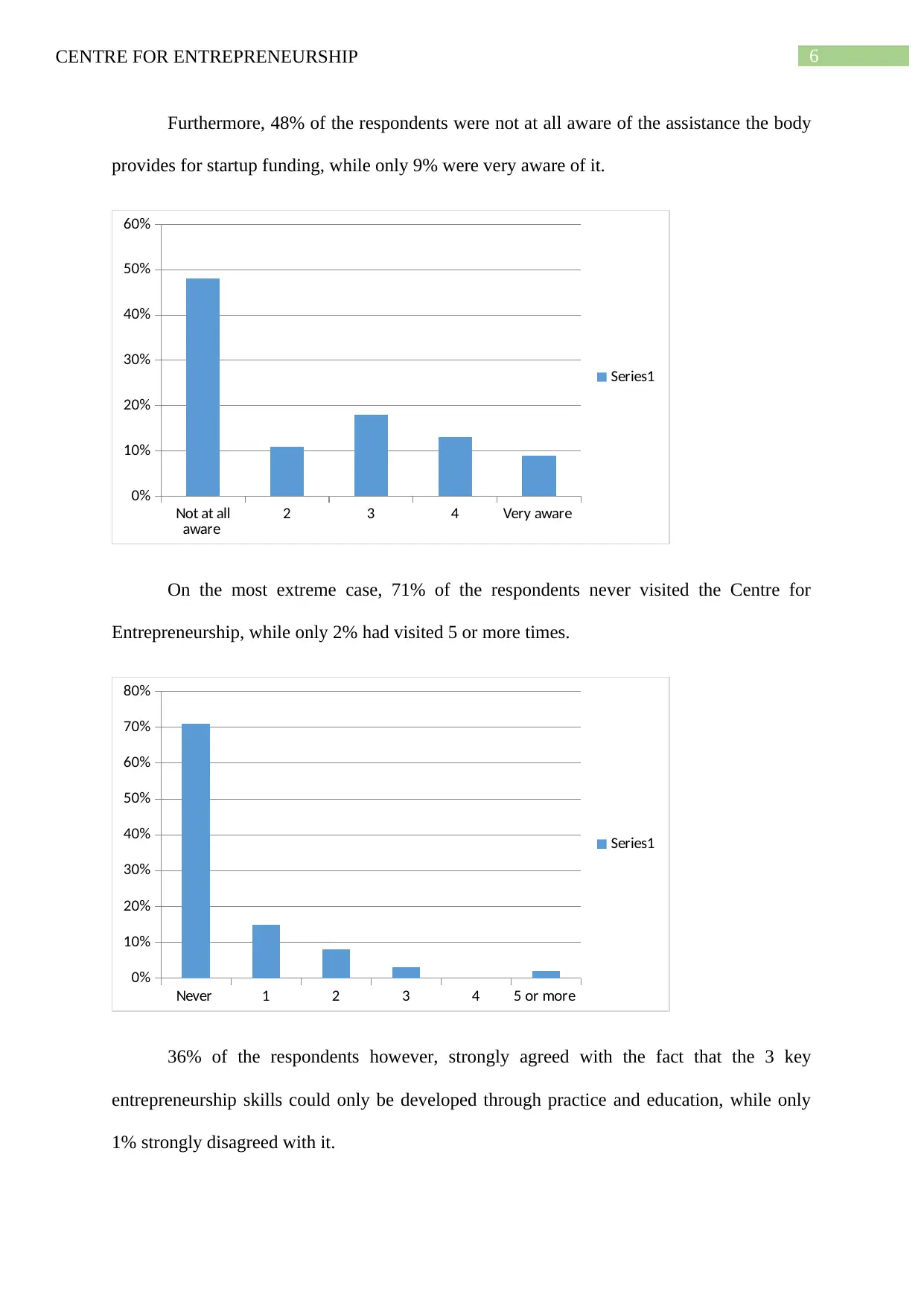
6CENTRE FOR ENTREPRENEURSHIP
Furthermore, 48% of the respondents were not at all aware of the assistance the body
provides for startup funding, while only 9% were very aware of it.
Not at all
aware 2 3 4 Very aware
0%
10%
20%
30%
40%
50%
60%
Series1
On the most extreme case, 71% of the respondents never visited the Centre for
Entrepreneurship, while only 2% had visited 5 or more times.
Never 1 2 3 4 5 or more
0%
10%
20%
30%
40%
50%
60%
70%
80%
Series1
36% of the respondents however, strongly agreed with the fact that the 3 key
entrepreneurship skills could only be developed through practice and education, while only
1% strongly disagreed with it.
Furthermore, 48% of the respondents were not at all aware of the assistance the body
provides for startup funding, while only 9% were very aware of it.
Not at all
aware 2 3 4 Very aware
0%
10%
20%
30%
40%
50%
60%
Series1
On the most extreme case, 71% of the respondents never visited the Centre for
Entrepreneurship, while only 2% had visited 5 or more times.
Never 1 2 3 4 5 or more
0%
10%
20%
30%
40%
50%
60%
70%
80%
Series1
36% of the respondents however, strongly agreed with the fact that the 3 key
entrepreneurship skills could only be developed through practice and education, while only
1% strongly disagreed with it.
Paraphrase This Document
Need a fresh take? Get an instant paraphrase of this document with our AI Paraphraser

7CENTRE FOR ENTREPRENEURSHIP
Strongly
agree Somewhat
Agree Not Sure Somewhat
Disagree Strongly
Disagree
0%
5%
10%
15%
20%
25%
30%
35%
40%
45%
Series1
Finally, 34% strongly agreed that it is very likely that they would be visiting the body
after the survey, while only 8% responded that it was not at all likely.
Very Likely Somwehat
Likely Not Sure Somewhat
Unlikely Very
Unlikely
0%
5%
10%
15%
20%
25%
30%
35%
40%
Series1
Analysis
From the responses regarding the awareness of the students about the Centre for
Entrepreneurship, it could be suggested that on a scale of 1-5 with 1 being not at all aware
and 5 being very aware, students’ awareness about the body and its activities and services
alike are 1, which means that they are not at all aware about the body or its activities. This is
because the degree of 1 is the mode in these responses. However, it has to be noted that many
Strongly
agree Somewhat
Agree Not Sure Somewhat
Disagree Strongly
Disagree
0%
5%
10%
15%
20%
25%
30%
35%
40%
45%
Series1
Finally, 34% strongly agreed that it is very likely that they would be visiting the body
after the survey, while only 8% responded that it was not at all likely.
Very Likely Somwehat
Likely Not Sure Somewhat
Unlikely Very
Unlikely
0%
5%
10%
15%
20%
25%
30%
35%
40%
Series1
Analysis
From the responses regarding the awareness of the students about the Centre for
Entrepreneurship, it could be suggested that on a scale of 1-5 with 1 being not at all aware
and 5 being very aware, students’ awareness about the body and its activities and services
alike are 1, which means that they are not at all aware about the body or its activities. This is
because the degree of 1 is the mode in these responses. However, it has to be noted that many
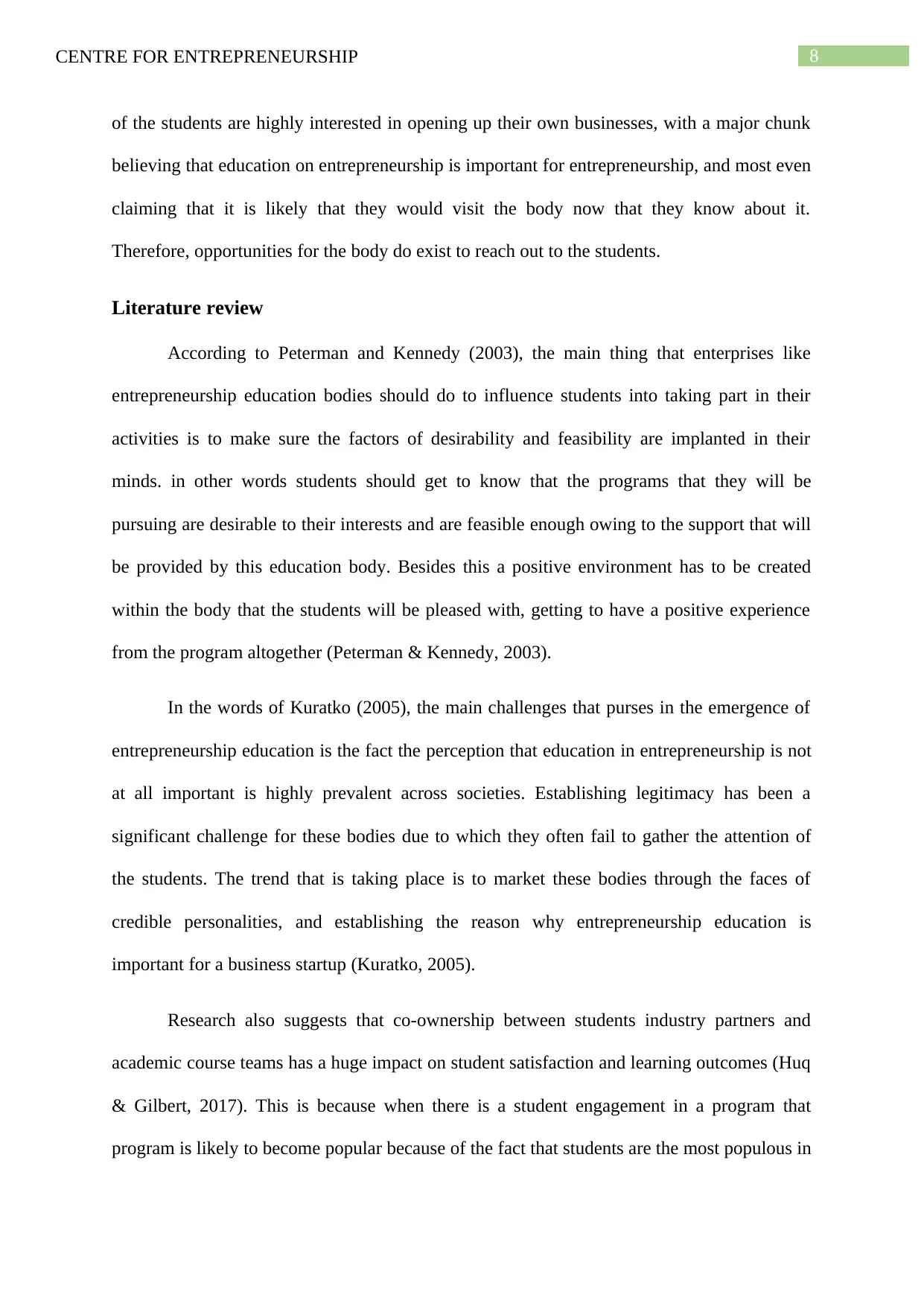
8CENTRE FOR ENTREPRENEURSHIP
of the students are highly interested in opening up their own businesses, with a major chunk
believing that education on entrepreneurship is important for entrepreneurship, and most even
claiming that it is likely that they would visit the body now that they know about it.
Therefore, opportunities for the body do exist to reach out to the students.
Literature review
According to Peterman and Kennedy (2003), the main thing that enterprises like
entrepreneurship education bodies should do to influence students into taking part in their
activities is to make sure the factors of desirability and feasibility are implanted in their
minds. in other words students should get to know that the programs that they will be
pursuing are desirable to their interests and are feasible enough owing to the support that will
be provided by this education body. Besides this a positive environment has to be created
within the body that the students will be pleased with, getting to have a positive experience
from the program altogether (Peterman & Kennedy, 2003).
In the words of Kuratko (2005), the main challenges that purses in the emergence of
entrepreneurship education is the fact the perception that education in entrepreneurship is not
at all important is highly prevalent across societies. Establishing legitimacy has been a
significant challenge for these bodies due to which they often fail to gather the attention of
the students. The trend that is taking place is to market these bodies through the faces of
credible personalities, and establishing the reason why entrepreneurship education is
important for a business startup (Kuratko, 2005).
Research also suggests that co-ownership between students industry partners and
academic course teams has a huge impact on student satisfaction and learning outcomes (Huq
& Gilbert, 2017). This is because when there is a student engagement in a program that
program is likely to become popular because of the fact that students are the most populous in
of the students are highly interested in opening up their own businesses, with a major chunk
believing that education on entrepreneurship is important for entrepreneurship, and most even
claiming that it is likely that they would visit the body now that they know about it.
Therefore, opportunities for the body do exist to reach out to the students.
Literature review
According to Peterman and Kennedy (2003), the main thing that enterprises like
entrepreneurship education bodies should do to influence students into taking part in their
activities is to make sure the factors of desirability and feasibility are implanted in their
minds. in other words students should get to know that the programs that they will be
pursuing are desirable to their interests and are feasible enough owing to the support that will
be provided by this education body. Besides this a positive environment has to be created
within the body that the students will be pleased with, getting to have a positive experience
from the program altogether (Peterman & Kennedy, 2003).
In the words of Kuratko (2005), the main challenges that purses in the emergence of
entrepreneurship education is the fact the perception that education in entrepreneurship is not
at all important is highly prevalent across societies. Establishing legitimacy has been a
significant challenge for these bodies due to which they often fail to gather the attention of
the students. The trend that is taking place is to market these bodies through the faces of
credible personalities, and establishing the reason why entrepreneurship education is
important for a business startup (Kuratko, 2005).
Research also suggests that co-ownership between students industry partners and
academic course teams has a huge impact on student satisfaction and learning outcomes (Huq
& Gilbert, 2017). This is because when there is a student engagement in a program that
program is likely to become popular because of the fact that students are the most populous in
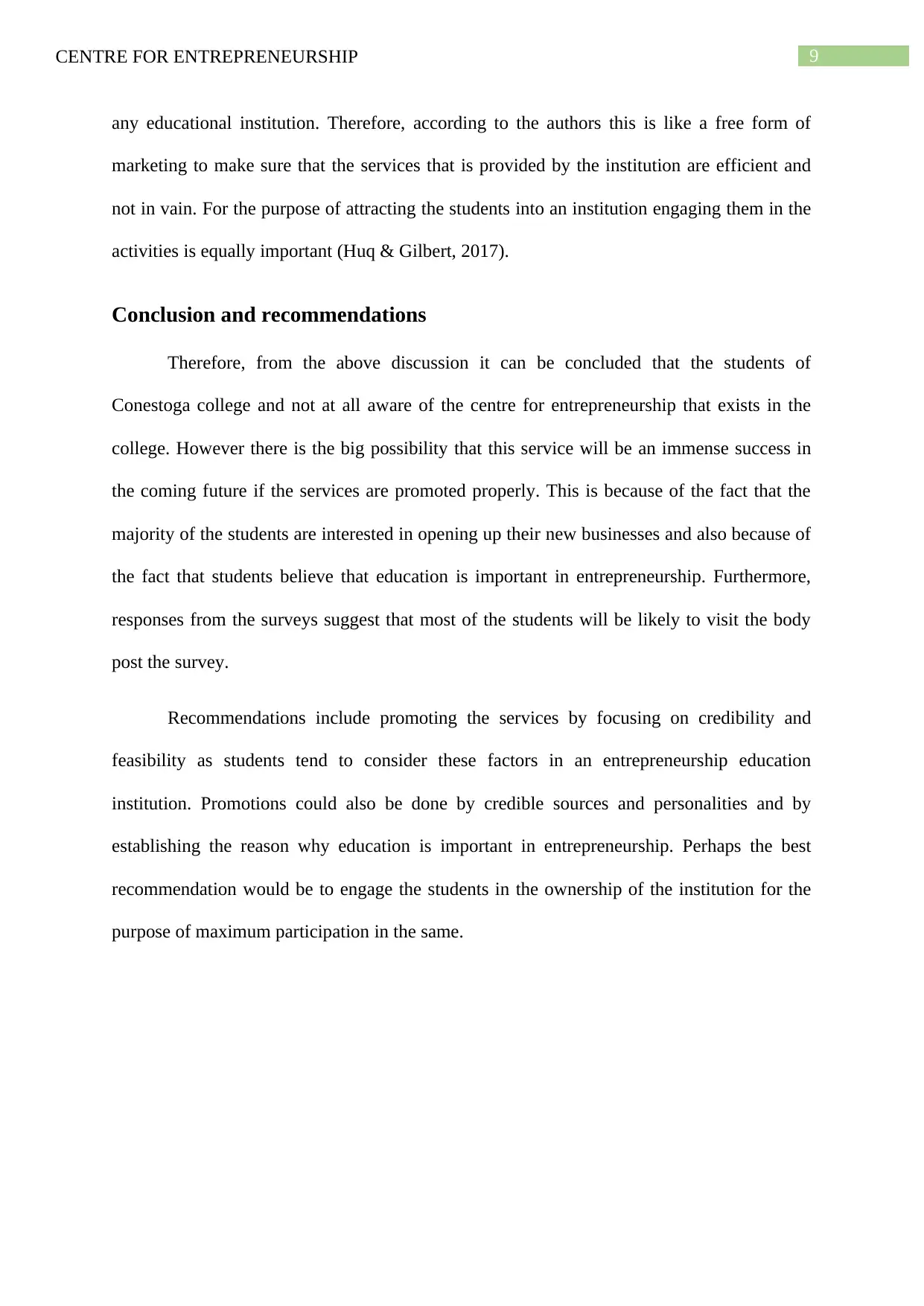
9CENTRE FOR ENTREPRENEURSHIP
any educational institution. Therefore, according to the authors this is like a free form of
marketing to make sure that the services that is provided by the institution are efficient and
not in vain. For the purpose of attracting the students into an institution engaging them in the
activities is equally important (Huq & Gilbert, 2017).
Conclusion and recommendations
Therefore, from the above discussion it can be concluded that the students of
Conestoga college and not at all aware of the centre for entrepreneurship that exists in the
college. However there is the big possibility that this service will be an immense success in
the coming future if the services are promoted properly. This is because of the fact that the
majority of the students are interested in opening up their new businesses and also because of
the fact that students believe that education is important in entrepreneurship. Furthermore,
responses from the surveys suggest that most of the students will be likely to visit the body
post the survey.
Recommendations include promoting the services by focusing on credibility and
feasibility as students tend to consider these factors in an entrepreneurship education
institution. Promotions could also be done by credible sources and personalities and by
establishing the reason why education is important in entrepreneurship. Perhaps the best
recommendation would be to engage the students in the ownership of the institution for the
purpose of maximum participation in the same.
any educational institution. Therefore, according to the authors this is like a free form of
marketing to make sure that the services that is provided by the institution are efficient and
not in vain. For the purpose of attracting the students into an institution engaging them in the
activities is equally important (Huq & Gilbert, 2017).
Conclusion and recommendations
Therefore, from the above discussion it can be concluded that the students of
Conestoga college and not at all aware of the centre for entrepreneurship that exists in the
college. However there is the big possibility that this service will be an immense success in
the coming future if the services are promoted properly. This is because of the fact that the
majority of the students are interested in opening up their new businesses and also because of
the fact that students believe that education is important in entrepreneurship. Furthermore,
responses from the surveys suggest that most of the students will be likely to visit the body
post the survey.
Recommendations include promoting the services by focusing on credibility and
feasibility as students tend to consider these factors in an entrepreneurship education
institution. Promotions could also be done by credible sources and personalities and by
establishing the reason why education is important in entrepreneurship. Perhaps the best
recommendation would be to engage the students in the ownership of the institution for the
purpose of maximum participation in the same.
Secure Best Marks with AI Grader
Need help grading? Try our AI Grader for instant feedback on your assignments.
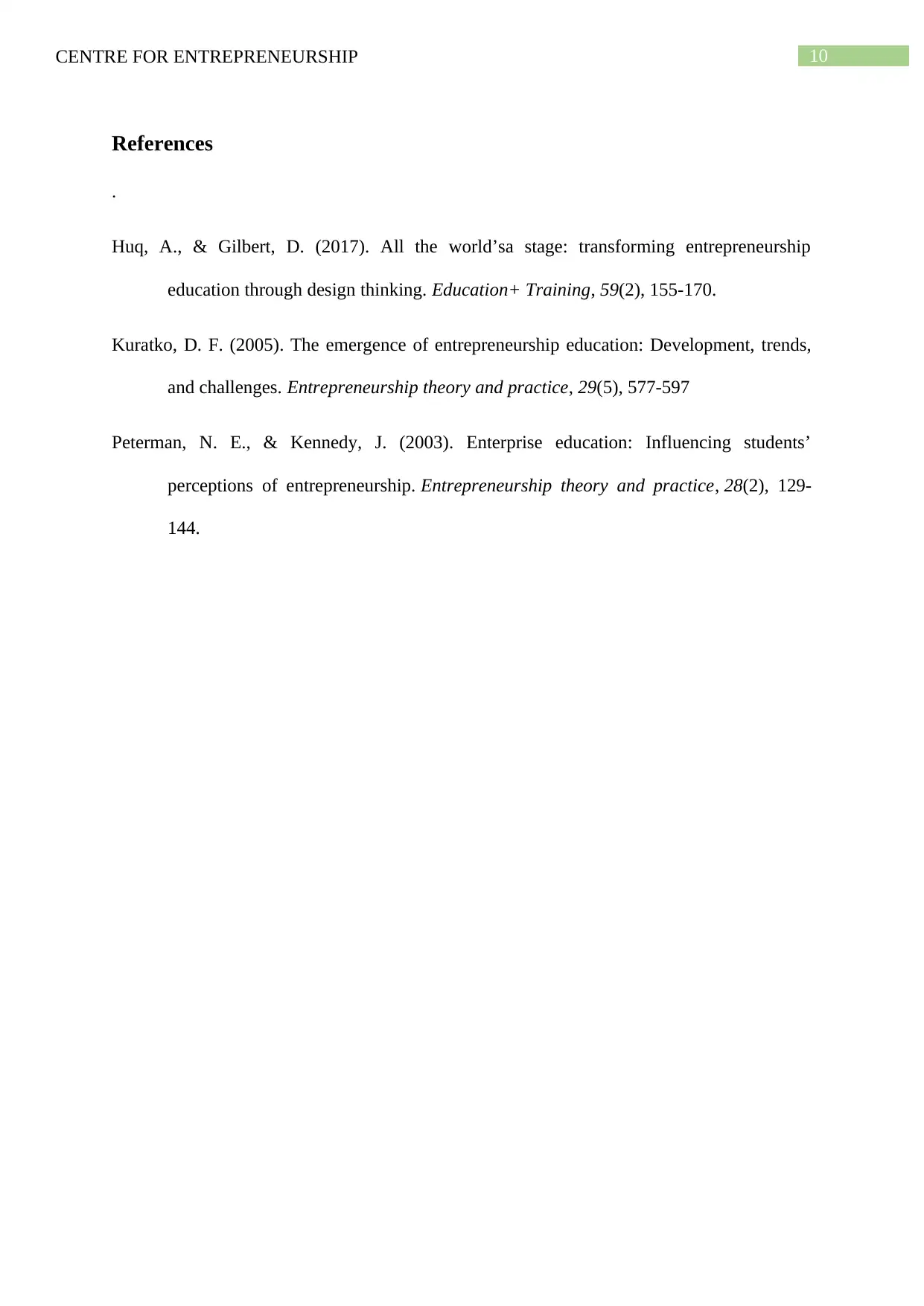
10CENTRE FOR ENTREPRENEURSHIP
References
.
Huq, A., & Gilbert, D. (2017). All the world’sa stage: transforming entrepreneurship
education through design thinking. Education+ Training, 59(2), 155-170.
Kuratko, D. F. (2005). The emergence of entrepreneurship education: Development, trends,
and challenges. Entrepreneurship theory and practice, 29(5), 577-597
Peterman, N. E., & Kennedy, J. (2003). Enterprise education: Influencing students’
perceptions of entrepreneurship. Entrepreneurship theory and practice, 28(2), 129-
144.
References
.
Huq, A., & Gilbert, D. (2017). All the world’sa stage: transforming entrepreneurship
education through design thinking. Education+ Training, 59(2), 155-170.
Kuratko, D. F. (2005). The emergence of entrepreneurship education: Development, trends,
and challenges. Entrepreneurship theory and practice, 29(5), 577-597
Peterman, N. E., & Kennedy, J. (2003). Enterprise education: Influencing students’
perceptions of entrepreneurship. Entrepreneurship theory and practice, 28(2), 129-
144.
1 out of 11
Related Documents
Your All-in-One AI-Powered Toolkit for Academic Success.
+13062052269
info@desklib.com
Available 24*7 on WhatsApp / Email
![[object Object]](/_next/static/media/star-bottom.7253800d.svg)
Unlock your academic potential
© 2024 | Zucol Services PVT LTD | All rights reserved.





